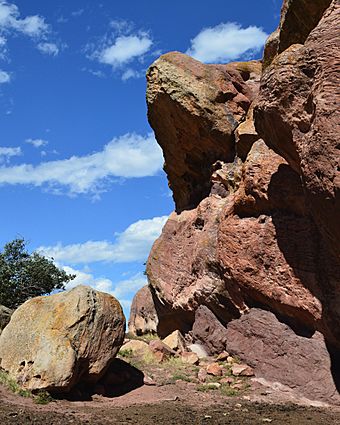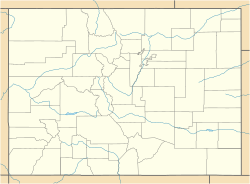LoDaisKa Site facts for kids
Quick facts for kids |
|
|
LoDaisKa Site
|
|
 |
|
| Location | Off U.S. Route 285 |
|---|---|
| Nearest city | Morrison, Colorado |
| Area | 3.4 acres (1.4 ha) |
| NRHP reference No. | 03000962 |
| Added to NRHP | September 25, 2003 |
The LoDaisKa Site is an important archaeological site in the Colorado mountains. It is found inside a rock shelter near Morrison. People lived in this rockshelter for a very long time. The earliest people lived there around 3000 BC, and others continued to live there until about 1000 AD. This means it was used for over 4,000 years!
Contents
Geography of LoDaisKa
The LoDaisKa Site is located near the town of Morrison. It sits in the southern Rocky Mountains foothills, about 6,200 feet (1,890 meters) high. The rockshelter is protected by a special 60-foot "red rock" formation. This area is unique because it's between two important places where early people lived: the Desert societies to the west and the Great Plains societies to the east. This made LoDaisKa a great spot for different groups to meet or pass through.
History of LoDaisKa Site
In the Denver area, scientists divide the time when prehistoric people lived into three main periods:
- The Paleo-Indian period
- The Archaic period
- The Ceramic period
At the LoDaisKa Site, archaeologists have found evidence of five different groups or "complexes." These are named A through E, with Complex E being the oldest.
Paleo-Indians at LoDaisKa
The time before the first humans arrived in Colorado was the Ice Age. This was about 16,000 years ago. Over thousands of years, the land changed a lot. Many large animals, like mammoths and giant sloths, died out. As glaciers melted, new rivers and mountains appeared.
Early Paleo-Indians, like those from the Clovis culture, used large tools. They hunted huge animals. Later, as the climate got warmer and drier, these giant animals disappeared. People adapted by hunting smaller animals and gathering wild plants. This led to new cultures, like the Folsom tradition, who used smaller tools.
The very first artifacts found at the LoDaisKa rockshelter are from the Paleo-Indian period. These belong to what archaeologists call Complex E.
Archaic Periods at LoDaisKa
The Archaic period generally lasted from about 5500 BC to 1 BC. During this time, people hunted smaller animals like deer, antelope, and rabbits. They also gathered wild plants for food. These groups moved around with the seasons to find the best hunting and gathering spots.
Later in the Archaic period, around 200-500 AD, people started growing corn. They also began making pottery. Pottery was useful for storing and cooking food.
The LoDaisKa site is linked to the Mount Albion complex. This was an Early Archaic culture that lived on the Plains. They were known for their special "Mount Albion corner-notched" spear points.
Ceramic Periods at LoDaisKa
The Early Ceramic period, also known as the Woodland period, began around 1 AD on the Plains. A big change during this time was the invention of pottery made with cord patterns. People also started living in more settled areas. They began using smaller spear points, which suggests they had developed bow and arrow technology.
Artifacts found at LoDaisKa show that people lived there through the Middle Ceramic period. It's rare to find a rockshelter in Colorado that was used for such a long time!
Archaeological Discoveries
At the LoDaisKa site, archaeologists have found many interesting things. These include animal hides, plant remains, wooden tools, and a large collection of stone tools. These artifacts date from 3000 BC to 1000 AD. They are grouped into five different time periods or "complexes," from A to E.
Artifacts by Complex Period
- LoDaisKa Complex E: This is the oldest complex. It included a special type of stone point and some small stone chips. These tools were made from gravel found below the rockshelter.
- LoDaisKa Complex D: This complex dates from about 3000 to 1500 BC. The tools found here are similar to those from the Great Basin Desert Culture in Utah and Arizona. They include triangular spear points, knives, choppers, and drills. There were also paint stones, beads, and gaming pieces. Evidence of early farming was found here too.
- LoDaisKa Complex C: From 1500 to 1000 BC, this complex shows links to cultures in Wyoming and Nebraska. The spear points found here were often shouldered with a concave base. Other tools included cutting tools and scrapers. People also used milling slabs and rock-filled hearths for cooking.
- LoDaisKa Complex B: This complex dates from 700 to 1000 AD. A new type of corn, like popcorn, was found here. The pottery from this time also matches the Woodland phase. Charcoal found shows people were living here during this period.
- LoDaisKa Complex A: This complex might be from Middle and Late Archaic peoples, after 90 AD. Pottery and corncobs were found. The corn is similar to corn found at Bat Cave in New Mexico, which is a very old site. The pottery is also similar to other known types.
Archaeologists also found seven lumps of red and yellow ochre stones, which might have been used as paint. They also found stone storage pits, called cists, which were used to store seeds.
In 1961, scientists used radiocarbon dating to figure out the age of the site. They confirmed that people first lived there around 3000 BC and stayed until at least 1000 AD. The spear points from LoDaisKa are similar to those found at other important sites in the Great Plains, like the McKean Site in Wyoming.
Excavation and Studies
- 1931–1932: Dr. E. B. Renaud did the first archaeological survey of sites in the Morrison area.
- Before 1958: LoDaisKa Bethel conducted the first big survey of the LoDaisKa site.
- 1958–1960: Henry J. and Cynthia C. Irwin led important excavations and studies at the site.
Historical Significance
The discoveries made at the LoDaisKa site were very important for archaeologists. Many other sites were dug up to help answer questions that came from the research at LoDaisKa. Because of the important archaeological evidence found there, the LoDaisKa Site was added to the National Register of Historic Places in 2003. This means it is recognized as a special place in American history.



